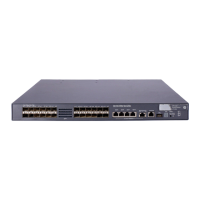211
Configuring IPv6 NetStream
The HP 5820X switch series do not support IPv6 NetStream.
Legacy traffic statistics collection methods, like SNMP and port mirroring, cannot provide precise network
management because of inflexible statistical methods or high cost (dedicated servers are required). This
calls for a new technology to collect traffic statistics.
IPv6 NetStream provides statistics on network traffic flows and can be deployed on access, distribution,
and core layers.
The IPv6 NetStream technology implements the following features:
• Accounting and billing—IPv6 NetStream provides fine-gained data about the network usage based
on the resources such as lines, bandwidth, and time periods. The ISPs can use the data for billing
based on time period, bandwidth usage, application usage, and QoS. The enterprise customers can
use this information for department chargeback or cost allocation.
• Network planning—IPv6 NetStream data provides key information, for example the AS traffic
information, for optimizing the network design and planning. This helps maximize the network
performance and reliability when minimizing the network operation cost.
• Network monitoring—Configured on the Internet interface, IPv6 NetStream allows for traffic and
bandwidth utilization monitoring in real time. Based on this, administrators can understand how the
network is used and where the bottleneck is, better planning the resource allocation.
• User monitoring and analysis—The IPv6 NetStream data provides detailed information about
network applications and resources. This information helps network administrators efficiently plan
and allocate network resources, and ensure network security.
IPv6 NetStream basic concepts
What is an IPv6 flow
IPv6 NetStream is an accounting technology to provide statistics on a per-flow basis. An IPv6 flow is
defined by the 7-tuple elements: destination address, source IP address, destination port number, source
port number, protocol number, ToS, and inbound or outbound interface. The 7-tuple elements define a
unique flow.
How IPv6 NetStream works
A typical IPv6 NetStream system comprises three parts: NDE, NSC, and NDA.
• NDE
The NDE analyzes traffic flows that pass through it, collects necessary data from the target flows, and
exports the data to the NSC. Before exporting data, the NDE may process the data like aggregation. A
device with IPv6 NetStream configured acts as an NDE.
• NSC
The NSC is usually a program running in Unix or Windows. It parses the packets sent from the NDE,
stores the statistics to the database for the NDA. The NSC gathers the data from multiple NDEs.

